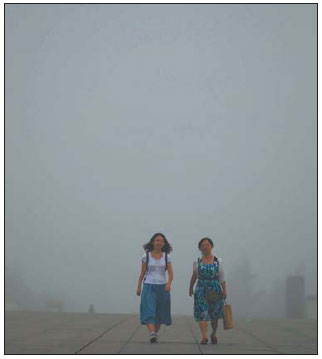Regional plan to strengthen anti-pollution campaign
|
People walk in a shroud of heavy pollution near the National Stadium in Chaoyang district on July 3. Wang Jing / China Daily |
BEIJING - A senior environmental official has revealed that the capital, Tianjin and Hebei province will establish a long-term joint project to clean up air pollution.
Official statistics show 30 percent of Beijing's atmospheric pollutants are transferred by airflow into the city from other provinces and regions.
"As they are spread by wind, pollutants don't distinguish administrative divisions from one another," said Wang Dawei, director of the atmospheric environment management office of Beijing environmental protection bureau. "Currently, our most urgent need is to unify the emission standards in the three regions."
He explained that although Beijing follows a high emissions standard, its neighbors have simply applied the national standard rather than set stricter measures.
"For instance, the emission limit of sulfur dioxide in the capital's Emission Standard of Air Pollutants for Boilers is 20 milligrams per cubic meter," he said. "The limit in the other two regions might be as high as 200 mg."
China Daily contacted several other officials at the bureau on Wednesday but none could give details on when or how the Beijing, Tianjin and Hebei authorities will cooperate in the future. However, all mentioned the likely return of a joint prevention and control system in place during the 2008 Olympic Games.
From late 2007, a cooperation proposal led by the former state environmental protection administration, and involving six cities and provinces near Beijing, ran until the end of the Olympics.
To ensure the promise of a green Games, governments in Beijing and five neighboring regions invested huge amounts of money and manpower to tackle atmospheric pollution, which resulted in improved air quality during the event. The situation worsened soon after the cooperation was halted when the Games finished.
Wang's comments on Friday came shortly after the bureau officially unveiled its 12th Five-Year Plan (2011-2015), which emphasizes emissions reduction, especially of atmospheric pollutants.
The plan increased the number of targeted pollutants from two to four. The two new types are oxynitrides and ammonia nitrogen.
Over the next five years, the government aims to lower emissions of oxynitrides by 12.3 percent and ammonia nitrogen by 10.1 percent, in addition to reducing sulfur dioxide by 13.4 percent and chemical oxygen demand by 8.7 percent.
To reach these goals, stricter restrictions on motor vehicles will be enacted. Li Kunsheng, director of the vehicle emission management division at the bureau, said the European Union's Euro 5 standard for exhaust emissions will be implemented in the first half of 2012. All new cars will have to comply with the higher standard.
Li said the bureau will also speed up the removal of older cars from the roads. By 2015, 400,000 will be removed, starting with 80,000 this year, in a bid to cut oxynitride emissions by 10,000 tons during the next five years.
"About 50 percent of oxynitride emissions come from motor vehicles," said Wang.
China Daily
(China Daily 07/13/2011 page7)



















